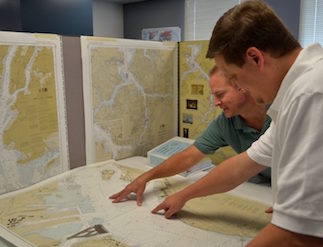The following is text of a news release from the National Oceanic and Atmospheric Administration (NOAA):
(WASHINGTON) — NOAA is initiating a five-year process to end all traditional paper nautical chart production and is seeking the public’s feedback via a Federal Register notice published on Nov. 15. Chart users, companies that provide products and services based on NOAA raster and electronic navigational chart (NOAA ENC) products, and other stakeholders can help shape the manner and timing in which the product sunsetting process will proceed. Comments may be submitted through NOAA’s online ASSIST feedback tool.
A long tradition in transition
For nearly 200 years, NOAA’s Office of Coast Survey has produced traditional paper nautical chart products. Originally, this took the singular form of hard copy paper charts; today, there are several raster digital chart formats available to download or print through a NOAA certified agent. Similar to the transition from road atlases to GPS navigation systems that we have witnessed in this digital era, we are also seeing the increased reliance on NOAA electronic navigational charts (ENCs) as the primary navigational product and the decreased use of traditional raster chart products. Since 2008, ENC sales have increased by 425 percent, while sales of paper charts have dropped by half.
The International Maritime Organization (IMO) now mandates that all large commercial vessels on international voyages use ENCs. In 2016, the U.S. Coast Guard started allowing regulated commercial vessels on domestic voyages to use ENCs in lieu of paper charts. Recreational boaters are also increasingly using electronic chart displays.
NOAA is in the midst of a multi-year program to improve its ENC coverage by replacing over 1,200 irregularly shaped ENC cells, compiled in over 130 different scales, with a standard gridded layout of ENCs, compiled in just a dozen standard scales. This will increase the number of ENC cells to about 9,000 and significantly improve the level of detail and consistency among ENCs. More information about improvements being made is in Transforming the NOAA ENC.
Another option for paper nautical charts
Ultimately, production will be shut down for all raster chart products and services associated with traditional NOAA paper nautical charts, including:
Print-on-demand (POD) paper nautical charts
Full-size chart PDFs
NOAA raster navigational charts (NOAA RNC)
BookletChart PDFs
NOAA RNC tile service
Online RNC viewer
Cancellation of these products and services will start in mid- to late 2020 and be completed by January 2025. More detailed information regarding this transition is explained in the document Sunsetting Traditional NOAA Paper Charts: End of Paper and Raster Nautical Chart Production and Introduction of NOAA Custom Charts. Over the next five years, NOAA will work to ease the transition to ENC-based products while continuing to support safe navigation. NOAA will focus on improving data consistency and providing larger scale coverage of NOAA ENC, as well as providing access to paper chart products based on ENC data, either through the NOAA Custom Chart prototype or third-party commercial data providers.
The online NOAA Custom Chart (NCC) application enables users to create their own charts from the latest NOAA ENC data. Users may define the scale and paper size of custom-made nautical charts centered on a position of their choosing. NCC then creates a geospatially referenced portable document format (GeoPDF) image of a nautical chart. Chart notes and other marginalia are placed on a separate PDF page. Users may then download, view, and print the output. NCC is an easy way to create a paper or digital backup for electronic chart systems or other global positioning system (GPS) enabled chart displays.
The prototype NCC is in the early phases of development and many improvements are needed to make it a viable replacement for traditional paper nautical charts. We hope you will try out the NOAA Custom Chart prototype and tell us what you think through NOAA’s online ASSIST feedback tool.

